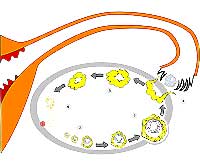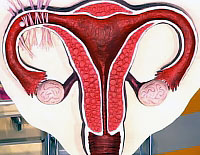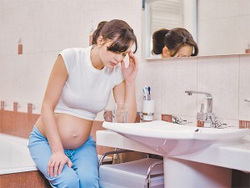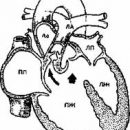Menstruation is the most important physiological process inherent in the female organism. This is not just a monthly phenomenon, often accompanied by pain and bad well-being, and the indicator that the woman is able to fulfill its natural purpose - to become a mother.
Content
What is menstruation
 It is hardly possible to overestimate the importance of this process, because on it, one can say, the very existence of life is based, the reproduction of the human race. Therefore, the sexual illiteracy of the part of the female population, the inattentive attitude to the disorders of the menstrual cycle is a serious problem even today.
It is hardly possible to overestimate the importance of this process, because on it, one can say, the very existence of life is based, the reproduction of the human race. Therefore, the sexual illiteracy of the part of the female population, the inattentive attitude to the disorders of the menstrual cycle is a serious problem even today.
Probably, every mother is able to explain the matured daughter, how to use gaskets during menstruation, but not every can competently express why this process occurs in the female body, which serves as it is the reason how it proceeds. Many women shy away from such conversations at all, forgetting that once the girls will grow up, they will also become mothers and they may have to face the same issues. And, unfortunately, it is often in families for such conversations, such a tough taboo is imposed that the girl first saw on his panties of blood stains, simply be afraid to admit this mom. This may be not only the cause of the appearance at an early age of gynecological diseases leading to infertility, but also a gross blow on a pediatric psyche.
The appearance of the girl menstruation
The appearance of menstruation girls is the first sign that the process of puberty has begun in her body. As a rule, this process proceeds simultaneously and interrelated with physical development. In other words, the beginning of menstruation, the growth of the mammary glands, pubic and axillary hair is in parallel with rounding the hips, the extension of the pelvis and other changes in the figure. These signs indicate that the girl began to turn into a girl. Paul ripening lasts about 5-6 years, and during this period of time in the body, cardinal changes occur. In the ovaries of every woman from birth «laid down» at 100-150 thousand immature eggs. When the process of puberty begins, the brain sends a signal to the ovaries that causes one of the eggs to ripe. One of the ovaries, in turn, sends a hormonal signal to the uterus, and it begins to prepare the mucous membrane to the coming changes: the thickness of the mucous membrane increases from 1 to 10 mm, it produces many blood and lymphatic vessels and glands. The uterus becomes soft and juicy, that is, ready to become a conspicuous child.
Ovulation
 Two weeks later, from the start of the ripening, the egg cell becomes mature, and it will release it from the ovary to the uterine tube. This process is called ovulation. Further two options are possible: either egg cell «faces» with spermatozoa and fertilized or dies. If fertilization did not happen, that is, the eggs died, in the uterus prepared for conception, the process of rejection of the thickened mucous membrane begins. It peers from the inner surface, exposing blood vessels. Thus, the walls of the uterus turn into a solid bleeding «wound». This is menstruation. It repeats every month to the same time, until the fertilization of the egg will occur or the climax will not begin.
Two weeks later, from the start of the ripening, the egg cell becomes mature, and it will release it from the ovary to the uterine tube. This process is called ovulation. Further two options are possible: either egg cell «faces» with spermatozoa and fertilized or dies. If fertilization did not happen, that is, the eggs died, in the uterus prepared for conception, the process of rejection of the thickened mucous membrane begins. It peers from the inner surface, exposing blood vessels. Thus, the walls of the uterus turn into a solid bleeding «wound». This is menstruation. It repeats every month to the same time, until the fertilization of the egg will occur or the climax will not begin.
Each girl has the time for the appearance of the first menstruation individually, since it all depends on what age the puberty begins. On average, gynecologists call numbers from 11 to 15 years. As a rule, if the menstruation has not appeared by 15 years, parents should have a reason for concern. If menstruation does not occur after 17 years, it indicates very serious violations in the development of the body. It requires a consultation of a specialist who is obliged to carry out a full examination, send a patient to analyzes and establish the cause of the delay of puberty. It should be noted that a healthy girl has the beginning of sexual development depends on hereditary signs, that is, her first menstruation will have about the same age as her mother, grandmother or aunt.
The duration of the menstrual cycle
The duration and regularity of the menstrual cycle is the first indicator of how much healthy woman is in an intimate plan. It is important to clarify that the duration of the cycle and the duration of menstruation itself - things are different, and they do not need to be confused. The cycle is considered to be a period of time from the first day of one menstruation until the first day of the next day, and the menstruation directly - the number of days to which blood and bleeding occurs. If the duration of menstruation can be different in different months, and it does not cause much concern, then the oscillations of the cycle duration talk about violations in the body.
Regularity of the menstrual cycle
It should be noted that the menstrual cycle quickly becomes regular only in 30% of women, and everything else is required at least one year on «Installation». Ideal gynecologists consider the 28-day cycle. It is often called lunar. In other words, if from the first day of one menstruation until the first day of the next day always passes 28 days, it is just great. On the middle, the normal cycle should not be less than 21 days and more than 35 days. In this framework, the permissible difference between adjacent cycles can be up to 10 days. If the number of days goes beyond these limits, and it is also constantly different, a doctor consultation is needed. Perhaps in this case there are disorders in the work of the ovaries.
Causes of menstrual disorders
It is important to take into account the fact that the causes of the disorders of the menstrual cycle are very often not gynecological diseases or deviations, but the most ordinary stress, the change of climate, bad ecology, nervous overvoltage. All this adversely affects the female organism, in its general state, and manifests itself primarily in «Racing» cycle. Therefore, if the cycle has been knocked out, you do not need to immediately fall into a panic and run into the nearest female consultation - you need to remember whether the listed factors listed in the recent past. Perhaps, to restore the normal duration of the menstrual cycle, it will be quite enough simpler sedative or the end of acclimatization.
As for the duration of the menstruation itself, it is impossible to bring exact data here, because for each woman the number of days is purely individually. The norm is considered 3-7 days, although it often happens 2 days, and 10 days. In addition, throughout life, the duration of menstruation may vary - in adolescence, say, 2-3 days, at 25-40 years - 5-7 days, after 40 years - again 2-3 days.
Most abundantly, blood stands out in the first two days of menstruation, and during the rest of the selection time is much more meager, that is, there are so-called «residues». This state of affairs is considered the norm for a healthy body. If allocations are abundant all days, you should consult with a gynecologist. But there is one nuance: abundant, as well as painful menstruation are the norm in the event that a woman uses such a contraceptive as an intrauterine spiral. The only thing that may cause anxiety, – Increased duration of menstruation. Even with the presence of a spiral, it should not last more than 7 days, if it is not a feature of a particular body.
Watching your cycle, a woman should pay attention not only to the quantity, but also on the quality of bloody discharge. As a rule, menstrual blood has a specific smell, not fully coagulated, but may contain some clots that appear during very abundant discharge. If a woman enjoys a spiral, these bunches are pieces of fertilized egg, which was rejected by the uterus. A very large number of clots, as well as their grainy structure indicate the presence of any disease or infection.









